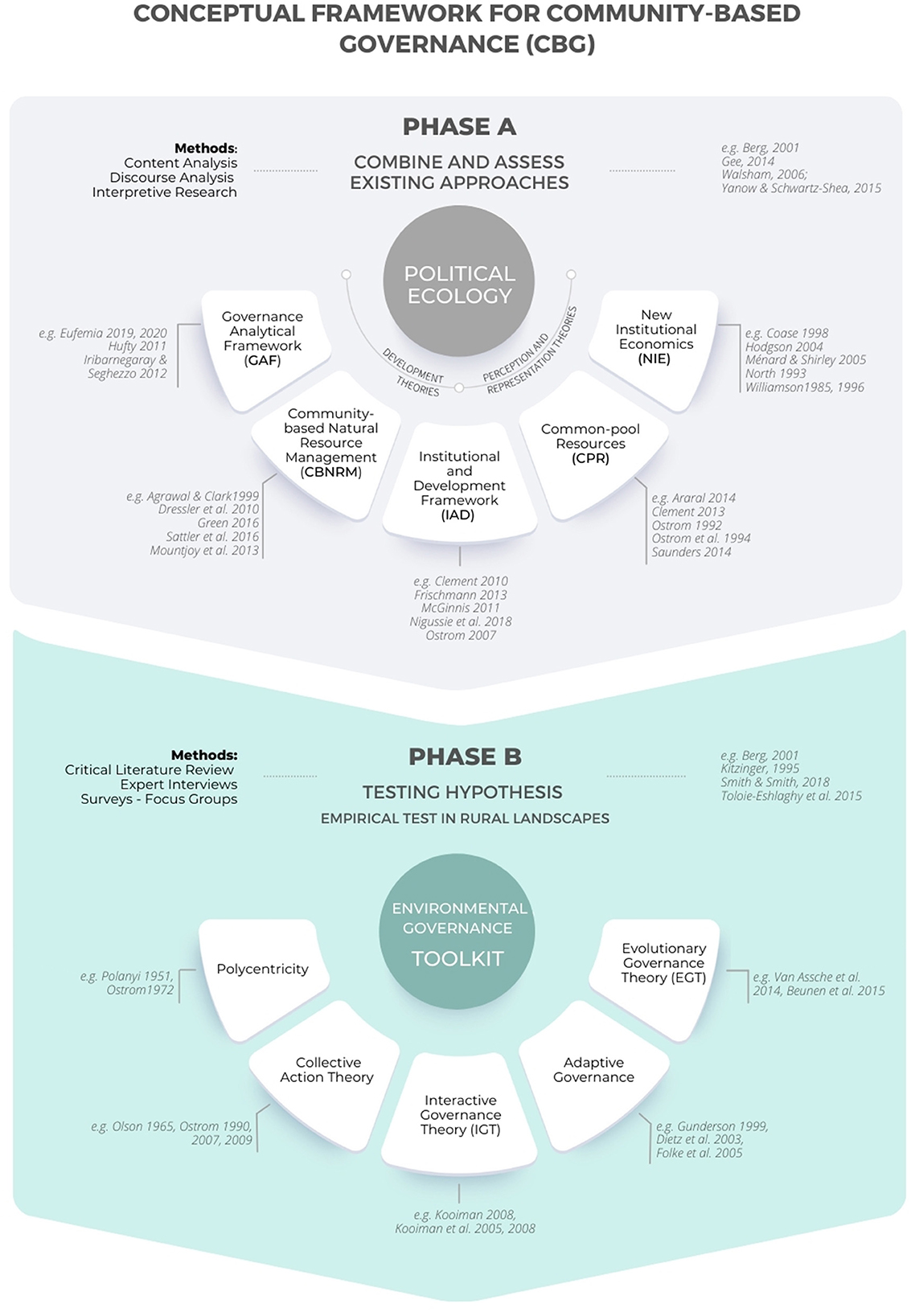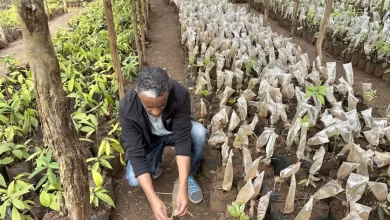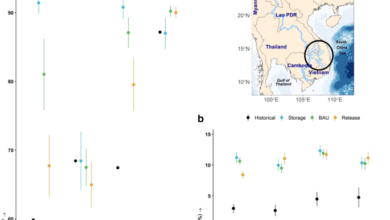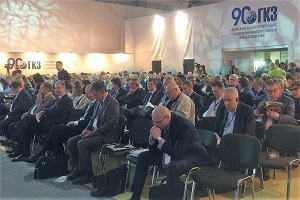Governing landscapes: An agenda for the assessment of grasslands and savannahs

1. Introduction
Political ecology may have started as a product of academic debate on critiques and notions in the interplay of environmental, political, economic and social issues. Yet, since the first epistemological elaborations of political ecology (Wolf, 1972; Blaikie and Brookfield, 1987), it has evolved to incorporate manifold concepts and collective systems (Robbins, 2011; Eufemia, 2020). For instance, environmental governance scholarship and practice lead the constant search for scientific/empirical knowledge regarding the access, use, and management of natural resources for sustainable development (Davidson and Frickel, 2004; Bridge and Perreault, 2009). The increasing interest in environmental governance is producing many frameworks, theories, and methodologies that are potentially useful for unveiling institutional aspects of environmental governance systems and their causal variables (Ostrom, 1990; Blaikie, 2008; Goldman et al., 2011; Partelow et al., 2020).
While its conceptualization provides scholars with interpretive tools that can be adapted to diverse social-ecological contexts, exploring the interaction and hybridization of unlike and heterogeneous rationalities/dimensions such as political and cultural values overflowing the field of the political economy of environmental goods, ecosystem services and collective integrated landscape management (Walker, 2007; Leyshon, 2018; Eufemia, 2020), two major gaps exist. On the one hand, the empirical practices of environmental governance scholarship have significant shortcomings concerning how they deal with interactions and the nexus between biophysical (structure of landscapes) and social sub-systems (Agrawal and Clark, 1999; Hufty, 2011; Kauneckis, 2014). On the other hand, institutional and governance concerns are often identified as the most severe obstacles to integrated landscape management approaches, where multiple productive land uses compete with environmental and biodiversity goals (Sayer et al., 2013). Filling these gaps will help environmental governance assessment/analysis to more fully accounts for social-ecological interactions in focal ecosystems alongside growing a deeper consideration of social capital, norms and institutions.
In this paper, our vision is to streamline and simplify the assessment of environmental governance (of focal ecosystems) specifically with respect to the nexus and interactions between biophysical and social sub-systems. As an example, we first provide background on the need for improved environmental governance scholarship in grasslands and savannahs, describing how a simplified and integrated toolkit could be a valid resource for scholars to choose between core (environmental governance) approaches and identify what fits specific problems/challenges best. This learning can contribute to a more comprehensive assessment leading to national and sub-national policies that create the enabling conditions for integrated landscape management. We then propose an agenda for future empirical analyses, including examples of research questions and suggested methods.
2. Overlooked ecosystems
Covering about 70% of the world’s agricultural and livestock area, grassland and savannah ecosystems have high biodiversity values and are critically important agricultural resources, especially in food-insecure regions (Suttie et al., 2005; Eufemia et al., 2019; Liu et al., 2022). In the Global South, grassland and savannah ecosystems are at the very center of human and economic development. On the African continent alone, savannahs occupy more than 50% of the land, generating a relationship of dependence with the people who live there: they depend on savannahs for water, food, medicines, timber and grass for construction, fuel wood, and charcoal (Pennington et al., 2018; Dudley et al., 2020). Savannahs also provide significant ecosystem services, including carbon storage and sequestration, nutrient cycling, and numerous cultural services (Dudley et al., 2020). However, due to increasing global food demand and the consequent rapid expansions of agricultural and extractive frontiers, grasslands and savannahs are degrading faster than ever before in human history (Osborne et al., 2018; Eufemia et al., 2020).
Often, one of the main driving forces behind environmental degradation is weak governance reform programs for integrated landscape management (Davies, 2016; Eufemia et al., 2020). Although many differences exist in the Global South, on a general note, governing and propriety right systems of grasslands and savannahs are complex/tense negotiations of power relations between political and economic agendas on human/industrial development and traditional/cultural values as well as customary practices, formal/informal norms, and institutions. For instance, in the Colombian Llanos most land is privately owned despite unclear land rights, the spread of land-market speculations and, most recently, the return of internal conflict processes associated with guerrilla/paramilitary groups’ territorial control (Eufemia et al., 2019). Economically, subsidized agricultural as well as extractive activities and their land acquisition potential trigger increasing infrastructure for fossil fuel extraction and monoculture cropland expansion (e.g., monoculture cultivation of rice and palm oil and the exploitation of hydrocarbons, including oil), either into natural/protected ecosystems, native pastures or intensification on already cultivated lands, with possible consequences for increasing land degradation (Romero-Ruiz et al., 2012). This situation has been having detrimental effects on local cultures, institutions and sustainable land use practices (e.g., traditional cattle ranching in flooded savannahs; Eufemia et al., 2019).
Altogether, negative consequences on grassland and savannah land management for the environment, local and indigenous communities, identities, and cultures are large and only expected to grow further (Eufemia et al., 2019). Additionally, the (re)production of old and new social-ecological conflicts in the Global South is often an ongoing threat, especially in rural contexts where strong economic pressures favor the accelerated incorporation of natural resources for immediate productive use and export (Taiye et al., 2017; Almeida de Souza et al., 2020; Eufemia et al., 2020; Li et al., 2020).
Notwithstanding these alarming developments, grasslands and savannahs are widely overlooked. To date, no systematic global characterization and distribution figures for grassland types exist. Further, global real-time systems to monitor remaining grasslands and savannahs, their degradation and conversion rates, biodiversity, carbon storage and sequestration also do not exist (Dudley et al., 2020; Buisson et al., 2021). Interdisciplinary social science knowledge on governance similarly remains scarce (e.g., on the causal variables and relations between governance with landscape management and degradation). Thus, the limited awareness/science-based knowledge of governance systems in grasslands and savannahs contributes to their vulnerability, likely weakening the effectiveness of public policies, as well as of global climate initiatives (e.g., UN Decade on Ecosystem Restoration, UN Framework Convention on Climate Change; Dudley et al., 2020; Eufemia et al., 2021; Török et al., 2021).
Against this background, very recent published accounts of designing strategies for sustainable land use and management, conservation, food security, conflict prevention/mitigation, and awareness raising, as well as for strengthening local governance show that this trend may be changing as overlooked grasslands and savannahs are receiving growing attention by the international community. While some studies promote technical guidelines for adapted governance and tenure systems, be they via pastoralism or other sustainable land use systems, others identify ecological priorities for grassland and savannah conservation/protection/restoration, and others again investigate the sense of collective responsibility and morality underlying grassland protection through behavior change strategies (FAO, 2020, 2021; WWF, 2020; Buisson et al., 2021; Eufemia et al., 2021; Cai et al., 2023). Regarding the link to public policy, new studies suggest spatially targeted policy instruments that can increase the provision of grasslands ecosystem services, as well as bottom-up approaches of policy implementation of subsidies and rewards for grassland management (Ding et al., 2022; Huber et al., 2022). To contribute to the growth of knowledge in this area, our suggested agenda responds to the need to collaboratively design simplified and comprehensive assessments of environmental governance of grasslands and savannahs, improving the current state of key indicators such as biodiversity and cultural heritage and mitigating exposure of targeted ecosystems. Based on these considerations, below we present a new framework and agenda for future empirical analysis.
3. An integrated framework for environmental governance
Because of the need for comprehensive/simplified assessments tailored by and for scholars and applicable to policy settings, our integrated framework aims to relate multiple existing approaches to environmental governance in a way that more fully accounts for social-ecological interactions in grassland and savannah ecosystems. Building on the multi-faceted conceptual framework of community-based governance (CBG) that is proven effective for focal ecosystem assessments in political ecology scholarship (Eufemia et al., 2021), we want to derive a specific, yet flexible, toolkit for environmental governance theory and practice. Under the umbrella of political ecology, CBG builds on development theories and perception-representation theories using five existing operational arrangements and their epistemologies. The five CBG’s theoretical approaches are:
The Governance Analytical Framework (GAF) focuses on social interactions in which actors make decisions regarding collective issues, thereby creating, reinforcing, or changing social norms and institutions (Hufty, 2011).
Community-based natural resource management (CBNRM) explores the role of power given to local communities to access, use, and manage natural resources (Agrawal and Clark, 1999; Green, 2016).
The Institutional and Development Framework (IAD) provides a multilevel conceptual map to investigate how people and communities self-organize across physical, institutional, and organizational boundaries to manage common resources sustainably, balancing individual use with the interests of a wider public (Ostrom, 2007a,b, 2011; Clement, 2010; McGinnis, 2011; Nigussie et al., 2018).
Common-pool resources theory (CPR) is a key concept for the sustainability of economic goods, particularly in the light of the so-called “tragedy of the commons” (Ostrom et al., 1994; Hardin, 2009; Cox et al., 2010; Saunders, 2014). For the most part, our take on CPR focuses on Ostrom’s principles for managing the commons.
New Institutional Economics (NIE) ties institutional theories and practices (e.g., regulations, customs, formal, and informal norms) with economic theories and practices (Williamson, 1985, 1996). As it includes work in political economy, the structure of property rights, public choice, hierarchies, and transaction costs, it helps explore how institutions deal with economic growth and development, either furthering it or constraining it.
Building on the above concepts, here, we suggest a way to streamline and simplify the assessment of environmental governance specifically concerning the nexus and interactions between biophysical (structure of landscapes) and social sub-systems. To this end, we propose the following two guiding research questions:
Research question 1 (RQ1): Given the biophysical and socioeconomic characteristics (local social-ecological context and governance challenges) of grassland and savannah landscapes, which aspects of which theoretical framework are likely to be most pertinent to assess environmental governance?
Research question 2 (RQ2): Does the resulting approach provide more meaningful empirical insights in a set of focal ecosystems?
Figure 1 visualizes the integration of the RQs into the frame of the CBG.
Figure 1. Conceptual framework for community-based governance (CBG; Eufemia, 2020).
Both the framework selection and analysis rely on the CBG empirical outcomes in the Global South (Eufemia et al., 2021) and our genuine recognition of the value of each of the frameworks taken individually. However, since academics/practitioners cannot achieve the same understanding of governing landscapes by using only one single framework or theory, we recommend hybridization and integration of the existing approaches. We argue that, in order to deal with the complexity of social-ecological systems (of grasslands and savannahs) and discover the conditions that affect decision-making processes over resource access use and management, political ecology and environmental governance scholarship can benefit from an integrated toolkit of theories specifically adjusted to suit the conditions of particular focal ecosystems. In this manner, and through a solid understanding of the unique, specific, and broader socioeconomics (historically, politically, biophysically, and spatially) in which actors and institutions are situated, more effective strategies for the sustainability of overlooked ecosystems can be designed and implemented.
Further, to derive testable hypotheses from our five chosen frameworks (GAF, CBRNM, IAD, CPR, and NIE), we propose to integrate a second and final set of knowledge from the five environmental governance clusters that, in our opinion, are most relevant (Figure 2). Taken from the work of Partelow et al. (2020), these are:
Polycentricity: refers to the analysis of essential features of complex socio-ecological systems, as they exist in practice. Polycentric governance explores multiple, diverse, and overlapping decision-making centers and processes.
Collective action theory: focuses on the variables hindering and/or enabling self-organization, social mobilization, and collective recourse outcomes from a community-level perspective.
Interactive Governance Theory (IGT): emphasizes aspects related to the governability of socio-ecological systems. By identifying problems and opportunities, as well as social organizational governance features, the IGT highlights the challenges of the system to be governed.
Adaptive governance: explores the collective learning processes of formal/informal institutions for resilient collaborative access, use, and management of natural resources.
Evolutionary governance theory (EGT): interprets power relations in and within governance systems from a perspective of coevolution among all sorts of forms of knowledge (e.g., narratives, images, traditional knowledge, etc.).
4. Proposing an agenda
We propose an agenda that enhances the theoretical and practical understanding of environmental governance and improves its rigor and impact. The suggested target audience includes practitioners, academics, and students in the field of ecosystem sustainability and conservation. Our program is divided into two phases: (A) The conceptual and inductive phase that aims to assess the five CBG theoretical approaches, combining those aspects of the theoretical frameworks that are most pertinent for assessing environmental governance in the grasslands and savannahs of the Global South. (B) The empirical test of the derived hypothesis on particular focal ecosystems in the Global South that serves as a proof of concept of the newly developed toolkit.
To achieve the aim of phase A, we recommend applying three methods: 1. Content analysis, 2. Discourse analysis of the five CBGs theoretical approaches (Berg, 2001; Gee, 2014), and 3. Interpretive research. With the first method, academics/practitioners should quantify and analyse the presence, meanings, and relationships of concepts embedded in the five CBGs’ theoretical frameworks. For example, they could take n (e.g., five) leading works of each theoretical framework (e.g., Ostrom’s IAD, Agrawal and Gibson’s CBNRM, etc.) and code for key content themes asking themselves: What is prominent? What is repetitive? What is different/similar? Correspondingly, using the second method, academics/practitioners should explore how the analysis of each of the five CBG theoretical frameworks, focusing of language and logic, is built and thought about. For instance, what is the goal of Ostrom’s IAD or Agrawal and Gibson’s CBNRM, and how it can be achieved? Lastly, methods of interpretive research are bridging conceptual hypotheses to the empirical cases on the ground. While assuming that social reality is shaped by human interactions and experiences, as well as the social and environmental contexts (ontology), we also consider the study of socio-economic, political, and historic scenarios in order to reconcile the subjective interpretations of research participants (epistemology; Walsham, 2006; Yanow and Schwartz-Shea, 2015).
Therefore, we encourage academics/practitioners to interpret and compare the social, economic, political, and historical realities of grassland and savannah landscapes. In practical terms, through literature reviews, expert interviews, and surveys, the key concepts of environmental governance will emerge, ready for discussion. For example, what are the hypotheses/implications with regard to either a post-colonial context or a post-conflict context? From content to discourse and interpretative research methods, we expect hypotheses to be built upon key concepts of the five selected environmental governance theories (e.g., polycentricity, collective action theory, IGT, adaptive governance, and EGT) including, for example, “equity of natural resources,” “trust and reciprocity,” and “economic profitability.”
Phase B is where these hypotheses can be tested in two distinct biophysical and socioeconomic systems that present different governance. Testing should ask: What are the key factors that will end up mattering for a solid assessment of environmental governance in a specific focal ecosystem? We suggest two groups of analysis, 1. The biophysical properties shaping environmental governance; and 2. The social properties that include various forms of social and financial capital, social stratification, social movements, political institutions, and gender relations, etc. (Faust, 2007; Klingebiel and Grimm, 2007; Faust and Croissant, 2008; Abe et al., 2016).
After completion of both phases A and B, we recommend the analysis of the implications for reliability and transferability of the environmental governance assessment toolkit as well as the limitations of the new framework for its use in other settings.
5. Final remarks
From early epistemologies of social-ecological systems and their dialectics, environmental governance scholarship and practice have evolved, developing several frameworks, theories, and methodologies that are important to understand and address social-ecological processes regarding the access, use, and management of natural resources for sustainable development. Examples include CBNRM and IAD, remarkable models that are proven to be effective across multiple implementations. Yet, very often these models are not related or connected to each other, resulting in a lack of a comprehensive understanding of how landscapes and natural resources are governed and transformed. This is particularly true in overlooked ecosystems, like grasslands and savannahs in the Global South. For these reasons, our contribution proposes a systematic research agenda to address this issue. Here above we suggest a simplified and integrated logic frame, built upon two sets of political ecology and environmental governance frameworks, connecting core approaches and theories in a way that more fully accounts for social-ecological interactions in grassland and savannah ecosystems. We conclude that whilst the empirical insights may be more meaningful, they need to consider both the limitations of usability and the applicability in the context of end-user induced stakeholder analyses. In this direction, the main limitation of this study concerns the risk of analytical generalization of the proposed agenda, which may omit causal links for users, local institutions, subgroups, or individuals. In addition to bringing out the behavioral dynamics and social norms (formal and informal) present in the field, some changes need to be made in the way the research is conducted.
Data availability statement
The original contributions presented in the study are included in the article/supplementary material, further inquiries can be directed to the corresponding author.
Author contributions
All authors listed have made a substantial, direct, and intellectual contribution to the work and approved it for publication.
Conflict of interest
IW was employed by Deutsche Gesellschaft für Internationale Zusammenarbeit (GIZ) GmbH.
The remaining authors declare that the research was conducted in the absence of any commercial or financial relationships that could be construed as a potential conflict of interest.
Publisher’s note
All claims expressed in this article are solely those of the authors and do not necessarily represent those of their affiliated organizations, or those of the publisher, the editors and the reviewers. Any product that may be evaluated in this article, or claim that may be made by its manufacturer, is not guaranteed or endorsed by the publisher.
References
Abe, J., Brown, B., Ajao, E. A., and Donkor, S. (2016). Local to regional polycentric levels of governance of the Guinea Current Large Marine Ecosystem. Environ. Develop. 17, 287–295. doi: 10.1016/j.envdev.2015.06.006
Agrawal, A., and Clark, C. G. (1999). Enchantment and disenchantment: The role of community in natural resource conservation. World Develop. 27, 629–642. doi: 10.1016/S0305-750X(98)00161-2
Almeida de Souza, A., Galvão, L. S., Korting, T. S., and Prieto, J. D. (2020). Dynamics of savanna clearing and land degradation in the newest agricultural frontier in Brazil. GISci. Remot. Sens. 57, 965–984. doi: 10.1080/15481603.2020.1835080
Berg, B. L. (2001). “Content Analysis” in Qualitative Research Methods, 4th Edn. (London: Pearson/Allyn and Bacon), 238–268.
Blaikie, P., and Brookfield, H. C. (1987). Land Degradation and Society. London: Methuen Books, 55–79.
Blaikie, P. E. (2008). Towards a future for political ecology that works. Geoforum 39, 765–772. doi: 10.1016/j.geoforum.2007.07.004
Buisson, E., Fidelis, A., Overbeck, G. E., Schmidt, I. B., Durigan, G., Young, T. P., et al. (2021). A research agenda for the restoration of tropical and subtropical grasslands and savannas. Restor. Ecol. 29, 13292. doi: 10.1111/rec.13292
Cai, Y., Ni, Q., and Zhao, M. (2023). Informal institutions moderate the relationship between environmental emotion and grassland governance behavior. Environ. Manag. 71, 405–420. doi: 10.1007/s00267-022-01754-0
Clement, F. (2010). Analysing decentralised natural resource governance: Proposition for a “politicised” institutional analysis and development framework”. Pol. Sci. 43, 129–156. doi: 10.1007/s11077-009-9100-8
Cox, M., Arnold, G., and Tomás, S. V. (2010). A review of design principles for community-based natural resource management. Ecol. Soc. 15, 438. doi: 10.5751/ES-03704-150438
Davidson, D. J., and Frickel, S. (2004). Understanding environmental governance: A critical re-view. Organ. Environ. 17, 471–492. doi: 10.1177/1086026603259086
Davies, J. (2016). “Enabling governance for sustainable land management,” in Land Restoration, eds I. Chabay, M. Frick, and J. Helgeson (Academic Press), 67–76.
Ding, W., Jimoh, S. O., Hou, X., Shu, X., Dong, H., Bolormaa, D., et al. (2022). Grassland ecological subsidy policy and livestock reduction behavior: A case study of herdsmen in northern China. Rangeland Ecol. Manag. . 81, 78–85. doi: 10.1016/j.rama.2022.01.002
Dudley, N., Eufemia, L., Fleckenstein, M., Periago, M. E., Petersen, I., and Timmers, J. F. (2020). Grasslands and savannahs in the UN Decade on Ecosystem Restoration. Restor. Ecol. 28, 1313–1317. doi: 10.1111/rec.13272
Eufemia, L. (2020). A Framework for Community-based Governance in Grasslands and Savannahs of South America, (Doctoral Dissertation), Humboldt-Universität zu Berlin, Berlin, Germany. Available online at: https://edoc.hu-berlin.de/handle/18452/22749 (accessed February 22, 2023).
Eufemia, L., Bonatti, M., Sieber, S., Schröter, B., and Lana, M. A. (2020). Mechanisms of weak governance in grasslands and wetlands of South America. Sustainability 12, 7214. doi: 10.3390/su12177214
Eufemia, L., Morales, H., Bonatti, M., Graser, M., Lana, M., and Sieber, S. (2019). Collective perception of anthropic and extractive interventions in the Colombian Llanos. Soc. Sci. 8, 259. doi: 10.3390/socsci8090259
Eufemia, L., Pérez, P., Rodriguez, T., Lozano, C., Bonatti, M., Morales, H., et al. (2021). Governance in post-conflict scenarios: Assessing models of community-based governance in the departments of Caquetá and Cesar (Colombia). Territ. Polit. Governance 2021, 1–23. doi: 10.1080/21622671.2021.1941231
FAO (2020). Mejorar la gobernanza de las tierras de pastoreo. Guías técnicas sobre gobernanza de la tenencia n.o 6. Rome: FAO.
FAO (2021). Pastoralism – Making variability work. FAO Animal Production and Health Paper n.o 185. Rome: FAO.
Faust, J. (2007). Statehood and Governance: Challenges in Latin America, No. 1/2007, Briefing Paper. German Institute of Development and Sustainability (IDOS), Bonn, Germany.
Faust, J., and Croissant, A. (2008). Statehood and Governance: Challenges in Southeast Asia (No. 1/2008). Briefing Paper. German Institute of Development and Sustainability (IDOS), Bonn, Germany.
Gee, J. P. (2014). Chs. 1 and 2 “Introduction” and “What Is Discourse Analysis” An introduction to Discourse Analysis: Theory and Method, 4th Edn. (London: Routledge), 1–29.
Goldman, M. J., Nadasdy, P., and Turner, M. D. (2011). Knowing Nature: Conversations at the Intersection of Political Ecology and Science Studies. Chicago, IL: University of Chicago Press. doi: 10.7208/chicago/9780226301440.001.0001
Huber, R., Le’Clec’h, S., Buchmann, N., and Finger, R. (2022). Economic value of three grassland ecosystem services when managed at the regional and farm scale. Sci. Rep. 12, 4194. doi: 10.1038/s41598-022-08198-w
Hufty, M. (2011). Investigating policy processes: The governance analytical framework (GAF). Res. Sustain. Develop. 2011, 403–424.
Kauneckis, D. (2014). Researching Complex Governance Arrangements: The impact of the Ostrom legacy on research methods and the analysis of institutional design. Pol. Matters 19.
Klingebiel, S., and Grimm, S. (2007). Statehood and Governance: Challenges in Sub-Saharan Africa (No. 3/2007). Briefing Paper. German Institute of Development and Sustainability (IDOS), Bonn, Germany.
Li, W., Buitenwerf, R., Munk, M., Amoke, I., Bøcher, P. K., and Svenning, J. C. (2020). Accelerating savanna degradation threatens the Maasai Mara socio-ecological system. Glob. Environ. Change 60, 102030. doi: 10.1016/j.gloenvcha.2019.102030
Liu, H., Hou, L., Kang, N., Nan, Z., and Huang, J. (2022). A meta-regression analysis of the economic value of grassland ecosystem services in China. Ecolog. Indicat. 138, 108793. doi: 10.1016/j.ecolind.2022.108793
McGinnis, M. D. (2011). An introduction to IAD and the language of the Ostrom workshop: A simple guide to a complex framework. Pol. Stud. J. 39, 169–183. doi: 10.1111/j.1541-0072.2010.00401.x
Nigussie, Z., Tsunekawa, A., Haregeweyn, N., Adgo, E., Cochrane, L., Floquet, A., et al. (2018). Applying Ostrom’s institutional analysis and development framework to soil and water conservation activities in north-western Ethiopia. Land Use Pol. 71, 1–10. doi: 10.1016/j.landusepol.2017.11.039
Osborne, C. P., Charles-Dominique, T., Stevens, N., Bond, W. J., Midgley, G., and Lehmann, C. E. (2018). Human impacts in African savannas are mediated by plant functional traits. New Phytolog. 220, 10–24. doi: 10.1111/nph.15236
Ostrom, E. (1990). Governing the Commons: The Evolution of Institutions for Collective Action. (New York, NY: Cambridge University Press), 22–57 doi: 10.1017/CBO9780511807763
Ostrom, E. (2007b). “Institutional rational choice: an assessment of the institutional analysis and development framework,” in: Theories of the Policy Process, 2nd Edn, ed P. A. Sabatier (Cambridge, MA: Westview Press), 21–64. doi: 10.4324/9780367274689-2
Ostrom, E. (2011). Background on the institutional analysis and development framework. Pol. Stud. J. 39, 7–27. doi: 10.1111/j.1541-0072.2010.00394.x
Ostrom, E., Gardner, R., and Walker, J. (1994). Rules, Games, and Common-Pool Resources. Ann Arbor, MI: University of Michigan Press.
Partelow, S., Schlüter, A., Armitage, D., Bavinck, M., Carlisle, K., Gruby, R. L., et al. (2020). Environmental governance theories: A review and application to coastal systems. Ecol. Soc. 25, 1–21. doi: 10.5751/ES-12067-250419
Robbins, P. (2011). Political Ecology: A Critical Introduction. Vol. 16. New York, NY: John Wiley & Sons.
Romero-Ruiz, M. H., Flantua, S. G. A., Tansey, K., and Berrio, J. C. (2012). Landscape transformations in savannas of northern South America: Land use/cover changes since 1987 in the Llanos Orientales of Colombia. Appl. Geograph. 32, 766–776. doi: 10.1016/j.apgeog.2011.08.010
Saunders, F. P. (2014). The promise of common pool resource theory and the reality of commons projects. Int. J. Commons. 8, 636–656. doi: 10.18352/ijc.477
Sayer, J., Sunderland, T., Ghazoul, J., Pfund, J. L., Sheil, D., Meijaard, E., et al. (2013). Ten principles for a landscape approach to reconciling agriculture, conservation, and other competing land uses. Proc. Natl. Acad. Sci. U. S. A. 110, 8349–8356. doi: 10.1073/pnas.1210595110
Suttie, J. M., Reynolds, S. G., and Batello, C. (2005). Grasslands of the World. No. 34. Rome: Food and Agriculture Organization.
Taiye, O. A., Dauda, M. M., and Emmanuel, A. O. (2017). Assessment of the effects of emerging grazing policies on land degradation in Nigeria. J. Appl. Sci. Environ. Manag. 21, 1183–1187. doi: 10.4314/jasem.v21i6.32
Török, P., Brudvig, L. A., Kollmann, J. N., Price, J., and Tóthmérész, B. (2021). The present and future of grassland restoration. Restorat. Ecol. 29, 13378. doi: 10.1111/rec.13378
Walker, P. A. (2007). Political ecology: Where is the politics? Progr. Hum. Geogr. 31, 363–369. doi: 10.1177/0309132507077086
Williamson, O. E. (1985). The Economic Institutions of Capitalism: Firms, Markets. Relational Contracting. New Haven, CT: Free Press; Yale University.
WWF (2020). Grassland and Savannah Ecosystems: An Urgent Need for Conservation and Sustainable Management. Berlin: Report WWF Germany.




